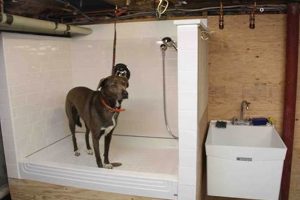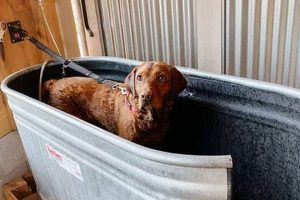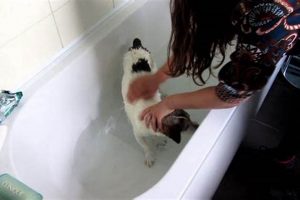Constructing a physical barrier on one’s property to contain canines, undertaken independently rather than by hiring a professional service, represents a tangible solution to pet management. This self-directed approach allows animal owners to customize enclosure parameters, materials, and visual aesthetics to their specific needs and preferences. A wooden structure erected around a yard by the owner, designed to prevent canine escape, serves as a pertinent illustration.
Implementing such a project offers several advantages. It provides a controlled environment for pets, enhancing their safety and reducing the risk of interactions with external hazards. Furthermore, it can represent a cost-effective alternative to professional installation, particularly for individuals with construction skills or a willingness to learn. Historically, self-reliance in property maintenance, including animal containment, reflects a tradition of resourcefulness and personal responsibility.
The subsequent sections will explore material selection, design considerations, construction techniques, and relevant legal compliance issues associated with building an enclosure for canines. Each aspect will be examined to provide a comprehensive understanding of the process and empower individuals to make informed decisions.
Essential Considerations for Canine Containment Structures
The following recommendations serve to guide the construction of secure and effective enclosures for dogs, ensuring their safety and well-being within defined property boundaries.
Tip 1: Prioritize Material Durability: Select robust materials, such as treated lumber or heavy-gauge wire mesh, capable of withstanding environmental exposure and resisting canine chewing or digging. A structure composed of weak or easily damaged components compromises its primary function.
Tip 2: Implement Adequate Height: Determine the necessary height based on the dog’s breed, size, and jumping ability. A minimum height of four feet is generally recommended, with taller breeds potentially requiring five or six feet to prevent escape.
Tip 3: Subsurface Barrier Installation: Extend the structure below ground level to deter digging. Burying wire mesh or concrete footings several inches deep can prevent canines from excavating beneath the barrier.
Tip 4: Secure Gate Mechanisms: Utilize robust latches and hinges designed for outdoor use. Ensure the gate closes securely and cannot be easily opened by the dog or inadvertently unlatched.
Tip 5: Regular Inspection and Maintenance: Conduct periodic inspections to identify and address any signs of damage or deterioration. Promptly repair weakened sections or replace compromised components to maintain the structure’s integrity.
Tip 6: Consider Terrain and Obstacles: Adapt the design to accommodate uneven terrain or existing landscaping features. Adjust the height and alignment as needed to maintain consistent ground clearance and prevent gaps.
Tip 7: Adhere to Local Regulations: Research and comply with all applicable zoning ordinances and building codes pertaining to fence construction. Failure to meet regulatory requirements may result in penalties or required modifications.
Implementing these measures contributes to the creation of a secure and reliable containment area, promoting the safety and responsible management of canine companions.
The subsequent sections will address aesthetic considerations and further refine the design process for optimal functionality and visual harmony with the surrounding environment.
1. Material Durability
The long-term effectiveness of any self-constructed canine enclosure hinges significantly upon the inherent durability of the constituent materials. Premature structural failure due to material degradation negates the intended purpose of confinement and introduces potential safety risks for both the animal and the surrounding environment. The choice of materials, therefore, constitutes a critical determinant in the overall success and longevity of such a project.
Material selection should account for several factors, including resistance to environmental stressors such as moisture, ultraviolet radiation, and temperature fluctuations. Furthermore, the selected components must withstand the potential destructive behaviors of the animal, including chewing, scratching, and attempts to breach the barrier through force. For instance, untreated lumber, while potentially less expensive initially, is susceptible to rot and insect infestation, leading to eventual structural compromise. Conversely, pressure-treated lumber or composite materials offer enhanced resistance to these elements, extending the lifespan of the fence. Similarly, chain-link fencing constructed from heavy-gauge wire is more resistant to damage from chewing or impact than lighter-gauge alternatives. A real-world example involves comparing two identical canine enclosures, one built with untreated pine and the other with treated cedar. After five years, the pine structure exhibited significant signs of decay and required substantial repairs, whereas the cedar structure remained largely intact. The understanding of material properties and their impact on durability translates directly into cost savings over the long term by reducing the frequency of repairs and replacements.
In summary, prioritizing material durability is paramount in the planning and execution of canine enclosures. A judicious selection process, informed by an understanding of material properties and potential environmental and animal-induced stressors, directly contributes to the sustained functionality, safety, and cost-effectiveness of the final structure. Failure to adequately address this aspect can result in premature failure, increased maintenance costs, and compromised canine safety.
2. Height Adequacy
Height adequacy represents a critical design parameter in self-constructed canine enclosures. Insufficient height compromises containment effectiveness, leading to potential escapes and associated safety concerns. Therefore, determining the appropriate vertical dimension is paramount in planning and executing a successful enclosure.
- Breed-Specific Jumping Ability
Different canine breeds exhibit varying jumping capabilities. Smaller breeds may require minimal height, whereas larger, more athletic breeds necessitate significantly taller barriers. For example, a Jack Russell Terrier typically requires a shorter fence than a German Shepherd. Ignoring breed-specific jumping ability can render the structure ineffective.
- Inclination and Escape Motivation
A canine’s motivation to escape influences the required height. An animal experiencing anxiety, boredom, or a strong desire to reach something outside the enclosure may exhibit greater jumping effort. Furthermore, the presence of nearby objects, such as sheds or trees, that the dog could use for leverage to clear the structure will also affect the necessary height of the enclosure.
- Fence Material and Construction Method
The selected material and construction method affect the perceived barrier height. A solid structure, such as a wooden fence, may deter jumping more effectively than a wire mesh fence of the same height. The visibility through the material can impact the dog’s perception of the boundary. A fence constructed with horizontal slats may unintentionally provide the dog with a series of steps to aid in climbing. The potential for weakness or flexibility of the fence may also change the height required to make the escape impossible.
- Legal and Regulatory Compliance
Local ordinances and homeowner association rules may stipulate minimum or maximum fence heights. Compliance with these regulations is essential to avoid fines or mandatory alterations. Furthermore, neighborhood aesthetics often inform height restrictions, balancing the need for effective containment with community standards.
Therefore, when embarking on such a do-it-yourself project, understanding the interplay between breed characteristics, environmental factors, and regulatory requirements is critical for selecting appropriate vertical dimensions. A failure to accurately assess these factors can compromise the enclosure’s effectiveness, potentially leading to escapes and related safety risks.
3. Subsurface Barrier
The integration of a subsurface barrier into a do-it-yourself canine enclosure represents a critical measure for preventing escapes accomplished through digging. Canine species, particularly certain breeds, exhibit a natural inclination to excavate, thereby undermining the integrity of surface-level fencing. The absence of a subsurface deterrent effectively negates the containment capabilities of an otherwise well-constructed structure. A primary cause of escape from enclosures lacking this feature is the canine’s ability to tunnel underneath the fence perimeter. This results in potential hazards for the animal, including traffic collisions, encounters with other animals, and exposure to harmful substances. The inclusion of a subsurface element addresses this vulnerability, augmenting the enclosure’s overall security.
Effective subsurface barriers typically consist of buried wire mesh, concrete footings, or strategically placed rocks extending below ground level. The depth and extent of the barrier depend on the breed’s digging tenacity and the soil composition. For instance, a Border Collie, known for its high energy and digging aptitude, may require a deeper and wider subsurface barrier compared to a less active breed. A practical application involves extending galvanized wire mesh at least 12 inches below ground and bending it outward at a 90-degree angle to create a horizontal apron. This configuration deters digging attempts by redirecting the canine’s efforts. Alternatively, pouring a concrete footing along the fence line provides a solid, impenetrable barrier against excavation. The selection of the appropriate method depends on factors such as cost, ease of installation, and soil conditions.
In summary, the implementation of a subsurface barrier is a fundamental component in the construction of a reliable canine enclosure. It directly addresses a common escape strategy, mitigating risks associated with unsupervised roaming. While material selection and installation techniques vary, the underlying principle remains consistent: to impede the canine’s ability to breach the enclosure through digging. The added effort and expense associated with incorporating a subsurface barrier are justified by the enhanced security and peace of mind it provides to pet owners.
4. Secure Gate
The integrity of a canine containment system hinges on the reliability of the gate mechanism. A compromised gate negates the benefits of a well-constructed perimeter, rendering the entire structure ineffective. Therefore, a secure gate represents a critical component in any do-it-yourself canine enclosure project.
- Latch Mechanism Integrity
The latching mechanism must possess sufficient strength and complexity to resist accidental or intentional opening by the canine. Simple hook-and-eye latches often prove inadequate, particularly for intelligent or persistent breeds. Alternatives include self-latching mechanisms, gravity latches, or double-locking systems that provide an added layer of security. A substandard latch exposes a vulnerability, potentially allowing the canine to escape without significant effort.
- Hinge Robustness and Placement
The hinges securing the gate must be robust enough to support the weight of the gate and withstand repeated use. Weak or improperly installed hinges can fail over time, causing the gate to sag or become misaligned, compromising its ability to close securely. Moreover, hinge placement should deter tampering by the canine. Exposed hinge pins may become targets for manipulation, potentially leading to gate failure. Consider using tamper-resistant hinges or welding the pins in place to prevent removal.
- Frame Rigidity and Alignment
The gate frame itself must exhibit sufficient rigidity to maintain its shape and alignment over time. A warped or twisted frame prevents the gate from closing flush against the gatepost, creating gaps that the canine can exploit. Constructing the frame from durable materials and ensuring proper bracing are essential for maintaining structural integrity. Proper gate alignment is also key, adjusting the gate to perfectly fit the opening preventing unnecessary gaps.
- Height Consistency and Ground Clearance
The gate height must match the overall height of the fencing to prevent the canine from jumping over it. Furthermore, minimal ground clearance prevents digging underneath the gate. A significant gap between the bottom of the gate and the ground provides an avenue for escape, particularly for breeds with digging inclinations. Ensure the gate extends close to the ground surface or incorporate a buried barrier to impede digging attempts.
These factors contribute to the overall security of the gate. Failure to address any one aspect compromises the security of the entire enclosure. A well-designed and properly installed gate mechanism is not an optional feature but rather an essential element in creating a reliable canine containment system, ensuring that the time and effort invested in the fencing are not rendered meaningless by a single point of failure.
5. Regular Maintenance
Sustained functionality and longevity of a self-constructed canine enclosure necessitate diligent regular maintenance. Infrequent upkeep precipitates structural deterioration, compromising the containment effectiveness and potentially leading to canine escape and associated hazards. Proactive maintenance represents an ongoing investment in the safety and security of the animal and the integrity of the enclosure.
- Inspection and Repair of Structural Components
Periodic visual inspection of all structural components, including posts, panels, gates, and hardware, is crucial. Identify and address signs of damage, such as rot, cracks, warping, or corrosion. Replace or repair compromised components promptly to prevent further deterioration and maintain structural integrity. Ignoring early signs of damage can lead to more extensive and costly repairs in the future. For instance, a small area of rot on a wooden post, if left unaddressed, can spread and weaken the entire post, eventually requiring complete replacement.
- Hardware Tightening and Lubrication
Over time, hardware such as screws, bolts, and hinges may loosen due to environmental factors and normal wear and tear. Regularly tighten all hardware to ensure secure connections. Lubricate hinges and latches to prevent corrosion and ensure smooth operation. Neglecting hardware maintenance can lead to gate misalignment, panel instability, and increased vulnerability to breaches. A squeaky hinge, if ignored, can seize and eventually break, requiring replacement of the entire hinge assembly.
- Vegetation Control and Debris Removal
Vegetation growth around the base of the enclosure can accelerate deterioration by trapping moisture and promoting rot. Regularly trim vegetation to maintain adequate airflow and prevent contact with the fencing materials. Remove debris, such as leaves, branches, and snow, which can accumulate and exert undue stress on the structure. Allowing vegetation to engulf the fence can obscure signs of damage and create hiding places for pests. Accumulation of snow can place excessive weight on the structure, leading to warping or collapse.
- Surface Treatment and Preservation
Apply protective coatings, such as paint, stain, or sealant, to wooden components to protect them from moisture, ultraviolet radiation, and insect infestation. Regularly reapply these coatings as needed to maintain their protective properties. Treat metal components with rust inhibitors to prevent corrosion. Surface treatment and preservation extend the lifespan of the materials and enhance the overall aesthetic appeal of the enclosure. A properly maintained wooden fence, treated with a quality sealant, can last significantly longer than an untreated fence exposed to the same environmental conditions.
These facets of regular maintenance are interdependent and contribute collectively to the sustained performance of the “diy fence for dogs”. A holistic approach, encompassing inspection, repair, hardware maintenance, vegetation control, and surface treatment, ensures the enclosure remains a secure and reliable barrier for the animal over its intended lifespan. Conversely, neglecting any of these areas can compromise the entire system, leading to potentially avoidable risks and expenses.
6. Code Compliance
Adherence to local building codes and zoning regulations represents a mandatory aspect of any self-directed canine enclosure project. Failure to comply with these legal mandates can result in penalties, required modifications, or even complete removal of the structure. Therefore, comprehensive understanding and meticulous adherence to relevant codes are paramount for responsible and lawful construction.
- Permitting Requirements
Many jurisdictions mandate the acquisition of a building permit prior to the commencement of fence construction. The permitting process ensures that the proposed structure meets minimum safety and aesthetic standards. Failure to obtain a required permit can result in fines, stop-work orders, and mandatory removal of the unpermitted structure. Examples of situations requiring permits include fences exceeding a certain height, fences located within easements, and fences constructed near property lines.
- Height Restrictions and Setback Requirements
Zoning regulations often stipulate maximum fence heights and minimum setback distances from property lines and public rights-of-way. These restrictions aim to preserve neighborhood aesthetics, maintain visibility for traffic safety, and prevent encroachments on neighboring properties. Non-compliance with height restrictions can result in the required removal of excess height, while encroachment violations may necessitate relocation of the entire structure. For instance, a code may specify a maximum fence height of six feet in residential areas and a setback of two feet from the property line.
- Material Restrictions and Aesthetic Guidelines
Some jurisdictions impose restrictions on the types of materials that can be used for fence construction and may establish aesthetic guidelines to ensure compatibility with the surrounding environment. These restrictions can dictate acceptable materials (e.g., wood, vinyl, wrought iron) and prohibit certain materials deemed unsightly or out of character with the neighborhood. Aesthetic guidelines may govern fence style, color, and transparency. Violation of material restrictions can result in the requirement to replace non-compliant materials, while aesthetic violations may necessitate alterations to conform to established standards.
- Easement and Utility Considerations
Building codes often address the placement of fences in relation to easements and underground utilities. Fences cannot obstruct access to easements or interfere with the maintenance or operation of underground utilities. Prior to construction, it is essential to identify and locate all easements and underground utilities on the property and ensure that the proposed fence location does not violate any applicable regulations. Encroachment on easements can lead to required relocation of the fence, while interference with utilities can create safety hazards and result in significant repair costs.
These facets of code compliance are not isolated requirements but rather interconnected elements that collectively govern the legality and acceptability of a “diy fence for dogs”. Neglecting any aspect can lead to significant legal and financial consequences. Prioritizing code compliance from the outset ensures a smooth construction process and a legally sound and aesthetically appropriate canine enclosure.
Frequently Asked Questions
The following section addresses common inquiries regarding the design, construction, and regulatory compliance of canine containment structures, providing concise and informative responses to assist individuals undertaking such projects.
Question 1: What is the optimal height for a containment structure designed for canine species?
The optimal height depends on the breed, size, and jumping ability of the canine. A minimum height of four feet is generally recommended; however, larger and more athletic breeds may require five to six feet to prevent escape.
Question 2: What materials offer the greatest longevity and resistance to canine-induced damage?
Pressure-treated lumber, heavy-gauge wire mesh, and composite materials exhibit superior resistance to environmental stressors and canine chewing. These materials offer enhanced durability compared to untreated wood or lighter-gauge wire.
Question 3: Is a subsurface barrier necessary for all canine containment structures?
A subsurface barrier is strongly recommended, particularly for breeds with a propensity for digging. Burying wire mesh or concrete footings below ground level effectively deters escape attempts through excavation.
Question 4: What features constitute a secure gate mechanism for a canine enclosure?
A secure gate mechanism incorporates a robust latch, durable hinges, a rigid frame, and minimal ground clearance. Self-latching mechanisms and tamper-resistant hinges enhance security.
Question 5: How frequently should containment structures be inspected and maintained?
Regular inspections should be conducted at least quarterly, with more frequent checks during periods of inclement weather. Promptly address any signs of damage or deterioration to maintain structural integrity.
Question 6: What steps are necessary to ensure compliance with local building codes and zoning regulations?
Prior to commencing construction, research all applicable zoning ordinances and building codes. Obtain necessary permits, adhere to height restrictions and setback requirements, and comply with material restrictions and aesthetic guidelines.
These responses provide a foundational understanding of essential considerations for canine containment structures. Thorough planning and diligent execution are critical for creating a safe and secure environment for canine companions.
The subsequent section will provide a summary of key recommendations and best practices for individuals engaged in designing and constructing canine enclosures.
DIY Fence for Dogs
This exploration of independently constructed canine enclosures underscores the multifaceted nature of such projects. Effective “diy fence for dogs” solutions necessitate meticulous planning, careful material selection, precise construction techniques, and diligent adherence to local regulations. The integration of robust materials, adequate height, subsurface barriers, secure gate mechanisms, and consistent maintenance routines collectively contributes to a secure and reliable containment system.
Ultimately, the success of a “diy fence for dogs” depends on a commitment to responsible pet ownership and a proactive approach to safety and security. The information presented serves as a guide for individuals seeking to create a safe and controlled environment for their canine companions, promoting both animal welfare and community harmony. Continued vigilance and adaptation to evolving needs are essential for long-term success.







